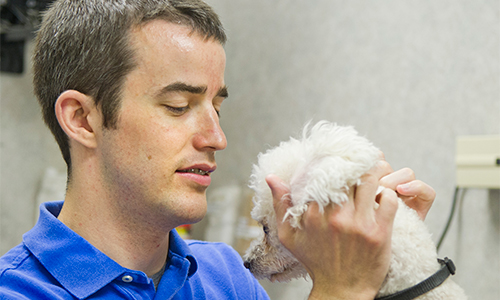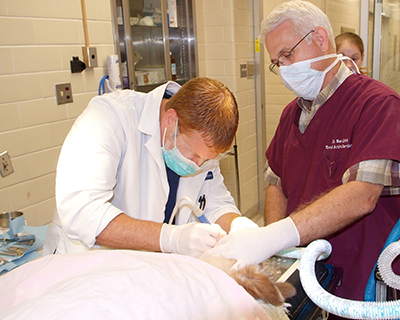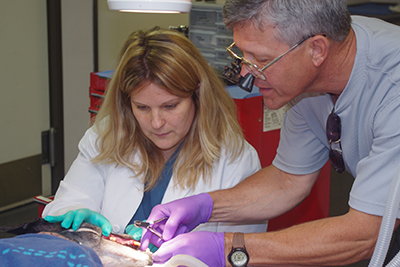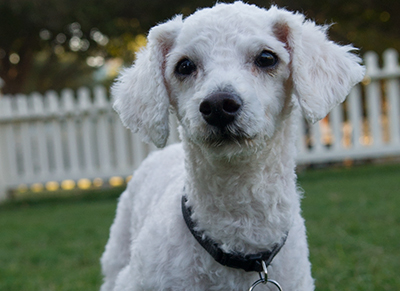Roscoe goes to the dentist

Seems this lovable bundle of fur needs some orthodontic attention.
One of Roscoe’s lower canines is forcing itself through the soft tissue of his palate instead of lodging between two upper teeth where it belongs. Luckily he has an inside track to Arlington, Texas veterinary dentist Dr. Bonnie Bloom. Luckier still, his “dad” knows a thing or two about dentistry.
The day before Roscoe’s appointment with Bloom in late May, Dr. Steve Ruso, aka Roscoe’s dad, graduated from the orthodontic residency program at Texas A&M University Baylor College of Dentistry. A native of Tampa, Fla., Ruso was in the midst of preparing for a move back to the Sunshine State when he took Roscoe to Bloom’s office.
“I noticed Roscoe’s canine was causing trauma to his palate, and I mentioned it to Dr. Bloom when we worked together on some research,” Ruso says. “She said to bring him in.”
Poodle meets orthodontic care
 Roscoe left his appointment sporting an orthodontic “power chain” on his left upper arch in addition to a sparkly set of freshly cleaned teeth.
Roscoe left his appointment sporting an orthodontic “power chain” on his left upper arch in addition to a sparkly set of freshly cleaned teeth.
His owner was instructed to adjust the chain one or two notches weekly for two weeks.
The objective was to create space for the lower canine to fit between the upper corner incisor and upper canine. After that space existed, an appliance was added to move the errant lower canine tooth into position.
“Roscoe is doing well,” Bloom said after his first follow-up appointment a month later. “We’re seeing a lot of tooth movement. Since dogs can’t wear a retainer, once the teeth are in place, I remove the chains but leave the buttons on just in case.”
Bloom had told Ruso about an alternate treatment approach at Roscoe’s initial visit, which would entail shortening the tooth dramatically and doing a root canal instead of moving it. Presented with this choice, however, Ruso – the orthodontist – elected to go for the tooth movement.
“A lot of people would rather do braces to preserve the teeth,” Bloom says.
“I don’t know of any concrete statistics on the need for orthodontic procedures in animals,” she adds. “A lot of times those problems go unrecognized. Today alone I had three patients with malocclusions. Occasionally an owner will notice an occlusion problem, but these cases are usually referred to me by other veterinarians.”
Misaligned teeth can lead to painful cavity-like lesions and increase tartar and gingivitis because they prevent the usual abrasive chewing action. Not solving problems like Roscoe’s 7-millimeter palatal defect can eventually lead to sinus infections, abnormal passageways called fistulas, or pockets later in life as the tissue hardens, Bloom explains.
While Roscoe’s orthodontic care was needed to alleviate a medical issue, Bloom cautions that orthodontics purely for cosmetic reasons – such as with show dogs – is unethical.
“If a dog is intact (not spayed or neutered), owners are required to sign an orthodontic release that they will not show or breed the dog,” she says.
A calling realized
 Bloom has limited her veterinary practice to dentistry since 2003, when she completed her residency, the credentialing and examination to become a fellow of the Academy of Veterinary Dentistry. But her calling was apparent years earlier during her childhood in Birmingham, Ala.
Bloom has limited her veterinary practice to dentistry since 2003, when she completed her residency, the credentialing and examination to become a fellow of the Academy of Veterinary Dentistry. But her calling was apparent years earlier during her childhood in Birmingham, Ala.
Dentistry runs deep in her family; her dad taught in the orthodontic department at University of Alabama at Birmingham for 18 years. Her brother and sister are both dentists. Bloom’s route to dentistry just took a more circuitous path.
“As long as I can remember, I always wanted to be a vet,” Bloom says. “I even wrote it down in kindergarten, although I spelled ‘veterinarian’ wrong. My parents still have that note.
“When I was growing up we had these old, beat-up dental chairs in the basement. I used to line up my stuffed animals on the stairs as ‘patients’ and practice treating them in the chairs.”
She is not the only individual with dental expertise at I-20 Animal Medical Center in Arlington, Texas. A&M Baylor College of Dentistry alumnus and recently retired dentist Dr. Ken Karger ’83 now works with Bloom to transfer his skill set from human dentistry to companion animals.
Karger and Bloom have jointly developed new techniques for jaw fracture repairs, crown preparations and root canal treatments, and Bloom has presented lectures and hands-on courses for veterinarians and dental specialists.
“Recently Bonnie and I were there until midnight doing surgery on a dog with a gunshot wound that affected the mandible,” Karger says. “We do some advanced stuff, including treating jaw fractures every two to three days. I have found this work fascinating; it has made me a much better dentist.”
Bloom recognizes the progress made and the improvements still to come in dentistry for animals, explaining that extraction forceps, dental elevators and endodontic devices already have been developed to meet the special needs of canines in particular.
“Veterinary dentistry has gained so much from the human side of dentistry,” Bloom says. “A lot of materials we buy are geared for humans, but we also need more specially adapted materials. There is a lot of room to expand in this area.”
Vet professor emphasizes oral health
 Dr. J.R. “Bert” Dodd is a clinical professor, veterinary dentistry specialist and 1979 graduate of Texas A&M University College of Veterinary Medicine. He joined the faculty in 2006 after 26 years in private practice in Austin, Texas.
Dr. J.R. “Bert” Dodd is a clinical professor, veterinary dentistry specialist and 1979 graduate of Texas A&M University College of Veterinary Medicine. He joined the faculty in 2006 after 26 years in private practice in Austin, Texas.
As a practicing veterinarian in the 1980s, Dodd recognized early on the need for improvement in dental care for the animals that passed through his practice. He had chosen veterinary school because “it encompassed everything,” but soon discovered one missing component.
“I had no idea that dentistry was not taught in vet school,” he says. “I had no training in it, and I became discouraged when an animal’s teeth would be worse six months after I cleaned them than they were before.
“A dental continuing education course I took in 1986 opened my eyes to see everything. I started taking every dental CE course I could find.”
By 1990, Dodd became a Fellow of the Academy of Veterinary Dentistry. He subsequently completed a multi-year residency in veterinary dentistry, and passed written and practical exams to become board certified in 2003 as a diplomate of the American Veterinary Dental College. Beginning in 1993, he limited his practice to dentistry.
“I saw four cases a day, and I was booked out for two weeks. I also provided a lot of continuing education to local vets. This had mutual benefits, as they acquired more knowledge, and it led to referrals for more advanced dentistry,” Dodd says.
Around 2002, A&M called to ask for his help with retired Baylor Bear mascot Bobby, housed at the Austin Zoo. The bear, which had a broken canine, was transported to Dodd’s private office for care. He received another call from A&M in 2003 for a root canal on Joy, the current Baylor Bear. This required Dodd to travel to College Station, Texas, and it marked the beginning of three years of weekly travel to A&M for dental cases on Fridays.
The Texas A&M veterinary college is still one of only a third of vet schools in the country with a board-certified veterinary dentist on the faculty. New this year: A two-week dental rotation is now required for fourth-year A&M vet students in the small-animal educational track. Previously it was an elective in the fourth year. Third-year vet students all receive six hours of lecture in dentistry, and Dodd offers an additional third-year elective consisting of eight hours lecture and eight hours hands-on lab.
 The specialty of veterinary dentistry has only been fully recognized since 1995 by the American Veterinary Medical Association.
The specialty of veterinary dentistry has only been fully recognized since 1995 by the American Veterinary Medical Association.
“People are starting to recognize that dental problems affect overall health,” Dodd says. “Practicing veterinarians are also getting continuing education on it; it’s offered everywhere. We’re about where human dentists were in the ’30s and ’40s.
“We are recognizing how important it is to practice preventive dentistry as opposed to therapeutic dentistry.”
The small-animal dental curriculum at the A&M vet school provides a basic understanding of proper tooth cleaning, the importance of anesthesia, explanation of endodontic care, and hands-on instruction in dental radiology, anatomy, oral pathology, oral surgery, occlusion evaluations, pediatric dentistry and feline dentistry.
“Dentistry wasn’t taught in the curriculum at A&M until about 10 years ago when one of the internal medicine docs, Dr. Deb Zoran, started teaching it as an elective for third-year vet students,” Dodd explains. “She later was instrumental in convincing the dean to hire me to take it over.”
A mentor’s lasting influence
The late Dr. Robert Bruce “Bob” Wiggs of Dallas was Dodd’s mentor through the alternate pathway residency, a four- to six-year part-time alternative to a traditional full-time veterinary dentistry residency program at a university or private practice.
Dodd worked with Wiggs from 1993 to 2001 and praises this legend in veterinary dentistry circles, who was an adjunct professor at A&M Baylor College of Dentistry and served the school for 30 years.
“He was an amazing man; absolutely unequalled,” says Dodd. “I never stumped him on a case or new product. He would say, ‘Oh, I tried that a couple years ago, and it didn’t work.’”
Wiggs’ influence on the specialty is significant. He mentored at least a dozen veterinary dentists over his career and is even the namesake of an award presented to an outstanding credentialed candidate or recent diplomate of the American Veterinary Dental College.
“He was involved in both types of residency programs,” Dodd says, “and usually had one to two full-time residents in his practice at a time as well as three to four alternate pathway students.”
Though dental residency slots have increased over the past several years, they are still competitive because of limited supply. Currently the United States only has 108 diplomates and 75 fellows in veterinary dentistry.
 Wiggs also was pivotal in Bloom’s career. She did an externship at his office for several weeks during her senior year at Auburn vet school. After graduation, he was her mentor through a one-year internship and two-year residency. She worked with him on dental cases at the Dallas Zoo over the weekends and was still working two days a week at his practice at the time of his death in November 2009. Bloom followed in his footsteps as an adjunct faculty member at A&M Baylor College of Dentistry.
Wiggs also was pivotal in Bloom’s career. She did an externship at his office for several weeks during her senior year at Auburn vet school. After graduation, he was her mentor through a one-year internship and two-year residency. She worked with him on dental cases at the Dallas Zoo over the weekends and was still working two days a week at his practice at the time of his death in November 2009. Bloom followed in his footsteps as an adjunct faculty member at A&M Baylor College of Dentistry.
“Everybody had so much respect for Dr. Wiggs, and he made such an impact on so many people,” says Bloom. “So many times when I have difficult cases I still reach for the phone instinctively to call him.”
She has continued caring for zoo animals over the years, including a recent root canal on a baboon at the Fort Worth Zoo.
“My zoo work is all volunteer,” Bloom explains. “You have to provide the equipment you need and donate your time. The veterinarians at the zoo take care of the anesthesia, and that’s nice.
The only zoo animal I’ve treated that didn’t require anesthesia was a sweet possum at the petting zoo. It didn’t form tooth enamel properly, so we had to seal its teeth twice a year.”
If there is one thing that’s predictable, it’s that dentistry for animals presents twists and challenges waiting to be solved. That is OK with Bloom.
“It’s fun,” she says. “After years of doing this, you think you’ve seen it all, but there’s always something new.”
Sidebar: Dental care for your pet
If it seems you need four hands instead of two to brush your pet’s teeth, your experience is undoubtedly frustrating – and very common.
“Routine preventive care at home is very important, but most dogs won’t allow you to work with their teeth every day,” says Dr. J.R. “Bert” Dodd, clinical professor and veterinary dentistry specialist at Texas A&M University College of Veterinary Medicine. “Now we have special treats, diets, additives, chew toys – all of which help. The use of home products with enzymes has made a difference.”
When purchasing dental products, look for the Veterinary Oral Health Council seal on the packaging. A list of accepted products can be found online.
 Preventive oral health care can start with choosing dry, crunchy kibble for your pet’s meals and offering hard biscuits after each meal. Just don’t expect dental disease to be signaled by your pet not eating.
Preventive oral health care can start with choosing dry, crunchy kibble for your pet’s meals and offering hard biscuits after each meal. Just don’t expect dental disease to be signaled by your pet not eating.
“Animals can have horrible disease in the mouth but still eat,” Arlington, Texas, veterinarian Dr. Bonnie Bloom says. “I look at everything but the teeth if they’re not eating.”
Bad breath is probably the single largest symptom of dental problems, but drooling and chewing on only one side can be additional signs.
An American Veterinary Dental Society study revealed more than 80 percent of dogs and 70 percent of cats develop some degree of periodontal disease by 3 years of age. Brushing is the most effective means of keeping teeth and gums healthy.
While it is easiest to start brushing when your pet is young, it’s never too late to start. One way to introduce the concept is to use a finger dipped in beef broth or tuna water to gently rub the pet’s teeth and gums, and then graduate to placing gauze over your finger.
“Get them used to it by working on the front teeth initially,” advises Dodd.
Eventually, using a soft-bristled brush and toothpaste made specifically for pets, concentrate on brushing the upper and lower first molars, as these are used the most for chewing, but be sure to brush the canines and other teeth, too. Never use “people toothpaste.”
And be sure to schedule routine professional cleanings. These must be done under anesthesia for safety and effectiveness. Be sure the veterinary practice has a dental X-ray unit before scheduling your pet’s dental care. “If they don’t have that, I wouldn’t go there,” Bloom says.
Solving your pet’s dental problems can help them feel – and act – years younger.